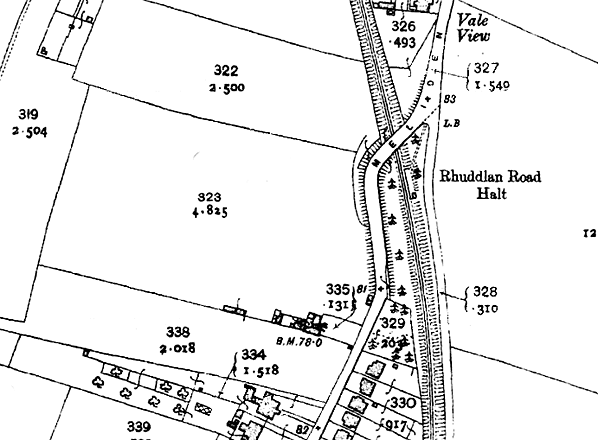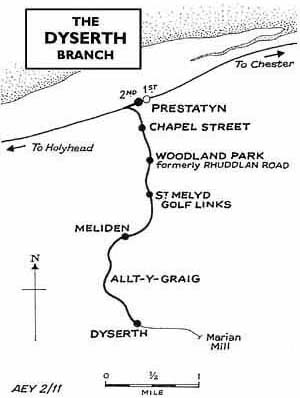
Station Name: WOODLAND PARK [Source: Paul Wright]
road_old2.jpg) An LNWR railmotor at Rhuddlan Road shortly after it was opened. At this early date there were no buildings or station signs on the platform.
Copyright photo from John Alsop collection 
road_old3.jpg)
Looking south from the Rhuddlan Road bridge at the station in about 1906 as an LNWR railmotor, en route to Dyserth, pulls away. There is still no building, but there are now signs which proclaim 'Rhuddlan Station' rather than 'Halt'. Although the suffix 'Halt' appears on the OS map above it was never shown on tickets or in timetables. It is possible that the sign did not exist and was added to identify the location of this postcard view.
Copyright photo from John Alsop collection road_old5.jpg) Looking south at Rhuddlan Road c.1910. The LNWR railmotor that operated the train service between 1905 and 1919 can be seen approaching the station. By this time the station had been provided with a simple wooden hut. There is a nameboard above the door but the station sign at the back of the platform seen in the picture above has now gone.
Photo from John Mann collection road_old4.jpg)
An LNWR railmotor calls at Rhuddlan Road c.1910. The simple facilities are clearly shown.
Copyright photo from John Alsop collection road_old1.jpg)
Looking south from the Meliden Road bridge at the station just before the Great War. A group of passengers can be seen boarding an LNWR railmotor.
Copyright photo from John Alsop collection park_old6.jpg)
Looking north at the site of Woodland Park in December 1972. The bridge carries Meliden Road over the line. The platform, which was both low and short, was located to the right of the picture with a ramp down from the road.
Photo by John Mann park3.jpg) Looking north at the site of Woodland Park in November 2010. The platform, which was short and low, was situated to the right, reached by a sloping footpath that led up to Meliden Road. When the station was first opened it was to have been called Meliden Road but to avoid confusion with Meledin station it was called Rhuddlan Road.
Photo by Paul Wright park2.jpg)
Looking south down the original access path to Woodland Park in November 2010.
Photo by Paul Wright Click on thumbnail to enlarge
|



park_thumb1.jpg)

 Home Page
Home Page